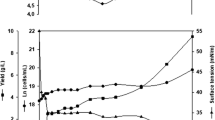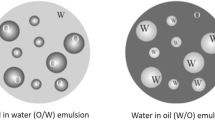Abstract
Dissolved air flotation (DAF) is a well-established separation process employing micro bubbles as a carrier phase. The application of this technique in the treatment of acid mine drainage, using three yeast biosurfactants as alternative collectors, is hereby analyzed. Batch studies were carried out in a 50-cm high acrylic column with an external diameter of 2.5 cm. High percentages (above 94%) of heavy metals Fe(III) and Mn(II) were removed by the biosurfactants isolated from Candida lipolytica and Candida sphaerica and the values were found to be similar to those obtained with the use of the synthetic sodium oleate surfactant. The DAF operation with both surfactant and biosurfactants, achieved acceptable turbidity values, in accordance with Brazilian standard limits. The best ones were obtained by the biosurfactant from C. lipolytica, which reached 4.8 NTU. The results obtained with a laboratory synthetic effluent were also satisfactory. The biosurfactants removed almost the same percentages of iron, while the removal percentages of manganese were slightly higher compared with those obtained in the acid mine drainage effluent. They showed that the use of low-cost biosurfactants as collectors in the DAF process is a promising technology for the mining industries.

Similar content being viewed by others
References
Besser, J. M., Brumbaugh, W. G., Allert, A. L., Poulton, B. C., Schmitt, C. J., & Ingersoll, C. G. (2009). Ecotoxicology and Environmental Safety, 72, 516–526.
Singer, P. E., & Stumm, W. (1970). Science, 167, 1121–1123.
Kontopoulos, A. (1998). Acid Mine Drainage Control. In S. H. Castro, F. Vergara, & M. A. Sánchez (Eds.), Effluent Treatment in the Mining Industry (pp. 57–118). Chile: University of Concepción.
Eger, P. (1994). Water Sci Technol, 29, 249–256.
Rubio, J., Souza, M. L., & Smith, R. W. (2002). Minerals Engineering, 15, 139–155.
Valente, T. M., & Gomes, C. L. (2009). Sci Total Environ, 407, 1135–1152.
Menezes, C. T. B., Isidoro, G., Rosa, J. J., Rubio, J., Leal-Filho, L. S., Galatto, S. L., & Santo, E. L. (2004). In: Treatment of acid mine drainage from Carbonífera Metropolitana. Proceedings of the 20th National Meeting on Minerals Treatment and Extractive Mettalurgy, Florianópolis. pp. 599–607 (in Portuguese).
Tessele, F., Rubio, J., & Misra, M. (1998). Minerals Engineering, 11, 535–543.
Emamjomeh, M. M., & Sivakumar, M. (2009). Journal of Environmental Management, 90, 1204–1212.
Peng, J.-F., Song, Y.-H., Yuan, P., Cui, X.-Y., & Qiu, G.-L. (2009). Journal of Hazardous Materials, 161, 633–640.
Zouboulis, A. I., Matis, K. A., Lazaridis, N. K., & Golyshin, P. N. (2003). Minerals Engineering, 16, 1231–1236.
Zouboulis, A. I., & Matis, K. A. (1995). Water Sci Technol, 31, 315–319.
Urum, K., Pekdemir, T., Ross, D., & Grigson, S. (2005). Chemosphere, 60, 334–343.
Beneventi, D., Allix, J., Zeno, E., Nortier, P., & Carré, B. (2009). Separation and Purification Technology, 64, 357–367.
Féris, L. A., Gallina, S. C., Rodrigues, R. T., & Rubio, R. (2001). Journal of Water Science and Technology, 43, 145–152.
Muthusamy, K., Gopalakrishnan, S., Ravi, T. K., & Sivachidambaram, P. (2008). Current Science, 94, 736–747.
Cortis, A., & Ghezzehei, T. A. (2007). Journal of Colloid and Interface Science, 313, 1–4.
Singh, A., Van-Hamme, J. D., & Ward, O. P. (2007). Biotechnology Advances, 25, 99–121.
Wang, S., & Mulligan, C. N. (2004). Water, Air, and Soil Pollution, 157, 315–330.
Mulligan, C. N. (2005). Environmental Pollution, 133, 183–198.
Coimbra, C. D., Rufino, R. D., Luna, J. M., & Sarubbo, L. A. (2009). Current Microbiology, 58, 245–249.
Asçi, Y., Nurbas, M., & Açikel, Y. S. A. (2008). Journal of Hazardous Materials, 154, 663–673.
Mulligan, C. N., Yong, R. N., & Gibbs, B. F. (2001). Engineering Geology, 60, 371–380.
Sen, R. (2008). Progress in Energy Combustion Science, 34, 714–724.
Peypoux, F., Bonmatin, J. M., & Wallach, J. (1999). Applied Microbiology and Biotechnology, 51, 553–563.
Lu, J. R., Zhao, X. B., & Yaseen, M. (2007). Current Opinion in Colloid and Interface Science, 12, 60–67.
Seydlová, G., & Svobodová, J. (2008). Central European Journal of Medicine, 2, 123–133.
Sandrin, T. R., & Maier, R. M. (2003). Environ Health Perspect, 111, 1093–1101.
Sobrinho, H. B. S., Rufino, R. D., Luna, J. M., Salgueiro, A. A., Campos-Takaki, G. M., Leite, L. F. C., et al. (2008). Process Biochemistry, 43, 912–917.
Rufino, R. D., Sarubbo, L. A., Benicio, B. N., & Campos-Takaki, G. M. (2008). Journal of Industrial Microbiology & Biotechnology, 35, 907–914.
Luna, J. M., Rufino, R. D., Sarubbo, L. A., & Campos-Takaki, G. M. (2008) In: Proceedings of the 11th National Meeting on Environmental Microbiology, Stability of the biosurfactant from Candida sphaerica, Fortaleza. pp. 577–579 (in Portuguese).
APHA. (1992). Standard methods for the examination of water and wastewater - American Public Health Association, American Water Works Association & Water Environment Federation. Washington: Victor Graphics, Inc.
CONAMA (2005) Resolution No 357, Environment National Council, Brazil (in portuguese).
Matis, K. A. (1995). Flotation Science and Engineering. New York: Marcel Dekker.
Acknowledgments
This work was financially supported by Conselho Nacional de Desenvolvimento Científico e Tecnológico (CNPq). We are grateful to Instituto de pesquisas Ambientais e Tecnológicas (IPAT), from Universidade do Extremo Sul Catarinense, Brazil and to Núcleo de Pesquisas em Ciências Ambientais (NPCIAMB) laboratories, from Universidade Católica de Pernambuco, Brazil.
Author information
Authors and Affiliations
Corresponding author
Rights and permissions
About this article
Cite this article
Menezes, C.T.B., Barros, E.C., Rufino, R.D. et al. Replacing Synthetic with Microbial Surfactants as Collectors in the Treatment of Aqueous Effluent Produced by Acid Mine Drainage, Using the Dissolved Air Flotation Technique. Appl Biochem Biotechnol 163, 540–546 (2011). https://doi.org/10.1007/s12010-010-9060-7
Received:
Accepted:
Published:
Issue Date:
DOI: https://doi.org/10.1007/s12010-010-9060-7




